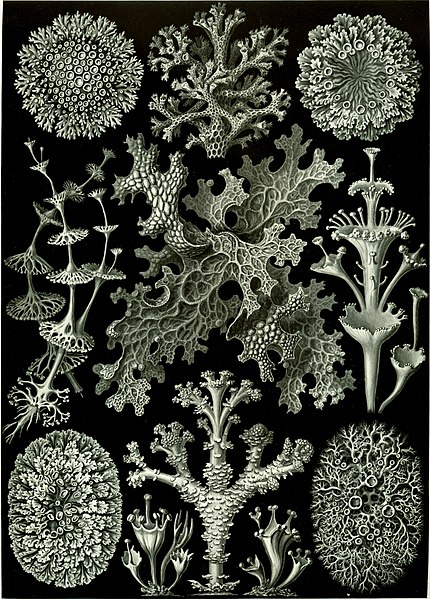Lichens can be found in the death zone of mountains (up to 7400m a.s.l. in the Himalayan), in rainforests, deserts, temperate regions and on the coast of the sea.
The body of lichen that is visible is formed by the fungus, and is called “thallus”. Lichens can divided into three broad groups based on the shape of the thallus: the fruiticose type consists of small tubules and branches, the foliose type which have a leaf-like plant body, and the flattened crustose type. This last group comprises the most common members of the lichen family, and can be found extensively on hard surfaces, including rock outcrops, boulders, tree bark, buildings and gravestones.

The first study related to Lichenometry, the dating method that use the growth rate of lichens for dating the surface that they colonize, was carried out by the Austrian scientist Roland Beschel in 1950.
Given similar rocks and climatic conditions, the larger the lichen colony, the longer will be the time passed since the growth surface becomes exposed.
Estimating the absolute age of a material from the lichen growing on its exposed surface first requires the determination of the growth rate of the area. After measuring lichen on surfaces of known age (for example by comparing lichens on historic buildings or geomorphic features with known age) it is possible to plot a growth curve that relates lichen diameters to time.
Then is it possible to compare lichen on a surface of unknown age, within the same area, with the grow curve to determinate the surface’s age.

 Rhizocarpon geographicum
Rhizocarpon geographicum
But because lichens colonies eventually grow together, and can no longer be measured individually, lichenometry as dating tool is used in a range less than 500 years. Under optimal circumstances lichenometry can provide a dating tool accurate to +-5 years over the last 200 years. So these organisms provide accurate dates for young glacial deposits, rockfalls and mudflows – all events that expose new rock surfaces on which lichen can grow.

Brodoa intestiniformis
References
BENEDICT (1990): Experiments on lichen growth. 1 Seasonal patterns and environmental controls. Arctic and Alpine Research 22:244-253
BESCHEL (1961): Dating rock surfaces by lichen growth and its application to glaciology and physiography (lichenometry). In Raasch (ed.) Geology of the Arctic vol.2. Univ. of Toronto Press: 1044-62
BESCHEL (1973): Lichens as a measure of the age of recent moraines. Arctic and Alpine Research 5:303-309
INNES (1982): Lichenometric use of an aggregated Rhizocarpon “species”. Boreas 11:53-57
INNES (1983): Use of an aggregated Rhizocarpon “species” in lichenometry an evolution. Boreas 12:183-190
INNES (1983): Size frequency distributions as a lichenometric technique: an assessment. Arctic and Alpine Research 15:285-294
INNES (1985): An examination of some factors affecting the largest lichens on a substrate. Arctic and Alpine Research 17:99-106
HEUBERGER (1966): Gletschergeschichte. Untersuchungen in den Zentralalpen zwischen Sellrain- und Ötztal. Wissenschaftliche Alpenvereinshefte 20:125
KONRAD & CLARK (1998): Evidence for an early Neoglacial glacier advance from rockglaciers and lake sediments in the Sierra Nevada, California USA. Arctic and Alpine Research 30:272-284
MATTHEWS (1992): The ecology of recently deglaciated terrain. Cambridge University Press
O´NEAL & SCHOENENBERGER (2003): A Rhizocarpon geographicum growth curve for the Cascade Range of Washington and Northern Oregon, USA. Quaternary Research 60:233-241
WALKER (2005): Quaternary dating methods. Wiley Press





1 Kommentar:
very informative post. thanks!
cheers
Kommentar veröffentlichen